PAINTING: Over the first few classes, we have begun cautiously to consider the human factor in painting and to what extent it can override stylistic concerns. In today's session, we shall confront the question full on, by considering a variety of paintings that express strong emotions and/or evoke such emotions in the beholder. The distinction is important, since it raises the question of how far we can trust our own responses and how much we should take facts about the artist's life into account.
The two works below were painted within four years of each other; Edvard Munch's The Scream (1893) has become
an icon of modern art; Vincent van Gogh's Self-Portrait of 1889 is commonly known as "Vincent in the Flames." There
are obvious similarities between the two—but they may be deceptive; click to compare them.



Some questions: Can you imagine not knowing the title of either picture? Can you conceive the Munch without the foreground figure, or the Van Gogh with a smoother background? Which painting is the more explicit in its emotion, and what makes it so? Where does each stand in comparison to the normal style of the artist?
MUSIC: For most of the second hour, we shall be reconsidering movements from The Planets by Gustav Holst (1918), specifically Mars, Jupiter, and Neptune. Feel free to review them; there are many performances out there on YouTube. I shall be showing the recent live concert in the BBC Proms, conducted by Susanna Mälkki. However, if you read music, you may like to watch the versions below, conducted by Sir Adrian Boult, who also conducted the premiere, and shown with Holst's own two-piano score; it is surprising what even such familiar pieces can reveal when you read as well as listen.
Mars, the Bringer of War
Jupiter, the Bringer of Jollity
Neptune, the Mystic
PEOPLE: Here are brief bios of the artists and poets we shall consider in the class, listed in
order of birth. You can now access all biographies via the BIOS link on the
syllabus page.
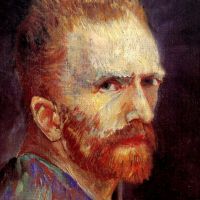 |
Vincent van Gogh, 1853–90. Dutch Post-Impressionist painter. Beginning in his native Holland with dark paintings of peasant life, his style was transformed when he went to Paris in 1886, and thence to Arles, where he lived with Paul Gauguin. Although prolific in his output, he suffered from severe depression and eventually shot himself, while living close to his doctor in the north of France. |
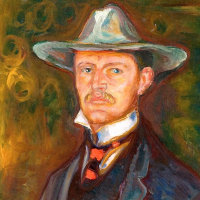 |
Edvard Munch, 1863–1944. Norwegian painter and printmaker. Tormented by the legacy of childhood trauma (he wrote "illness, madness, and death were the black angels that kept watch over my cradle"), Munch nevertheless managed to turn his neuroses into art that can stand with the most advanced painting in the rest of Europe and makes him a prime exponent of Expressionism. |
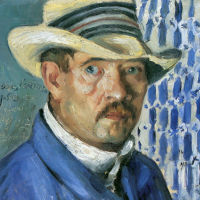 |
Lovis Corinth, 1858–1925. German painter. After training in Paris, he was hailed as a proponent of "German Impressionism," although his affinities were more with Rembrandt and Manet. Two things affected the Expressionist freedom of his later style: marriage to one of his young students, and his recovery from a crippling stroke in 1911. |
 |
Henri Matisse, 1869–1954. French painter and sculptor. Matisse and Picasso stand as the giant pillars of French art in the first half of the 20th century. Matisse was the slower starter and the less versatile, but he stands alone for the richness of his color and the sensuality of his forms, whether in painting or in sculpture. Suffering from crippling arthritis at the end of his life, he produced a completely new oeuvre in colored-paper collage. |
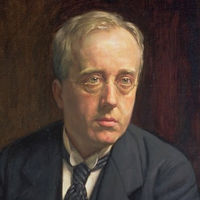 |
Gustav Holst, 1874–1934. English composer. The son of a church organist of Swedish descent, Holst studied first the piano and then the trombone. With Ralph Vaughan Williams, he was largely responsible for the revival of interest in English folk music at the turn of the century. He worked most of his life as a church musician and in education, but wrote numerous works, of which The Planets (1918) is the largest and most famous. |
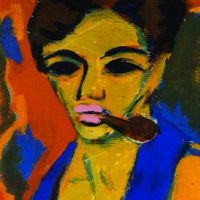 |
Ernst Ludwig Kirchner, 1880–1938. German painter. Kirchner was the co-founder of the Expressionist group Die Brücke (the bridge) in 1905, and its leading figure, painting incisive angular figures in strong colors. At the outbreak of WW1, he volunteered for service as a driver, but was invalided out due to poor health, both mental and physical. He never fully recovered, and spent the last part of his life in seclusion in Switzerland. |
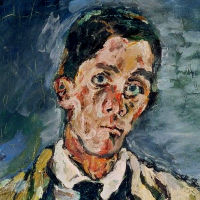 |
Oskar Kokoschka, 1886–1980. Austrian painter and playwright. One of the leading Expressionist painters in Vienna, Kokoschka was also a poet and playwright. Starting mainly as a portraitist with a distinctive style of very free brushwork, he widened his interests to include landscapes, cityscapes, and other subjects when he began to travel in the later 1920s. Denounced as degenerate by the Nazis, he became first a Czech and later a British citizen. |
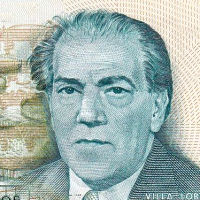 |
Heitor Villa-Lobos, 1887–1959. Brazilian composer. Villa-Lobos studied the cello with his father and made an early living playing in orchestras, but as a composer he was largely self-taught. Visiting Paris in 1927–30, he picked up the prevailing neo-classicism, and returned to Brasil to write a series of pieces called Bachianas Brasilieras infusing baroque forms with Brazilian folk styles. |
ART: For the paintings discussed (or intended to be discussed) in class see below. Scroll to the end or click these links to reach the sections on MUSIC and READING.
COMPARISON 1
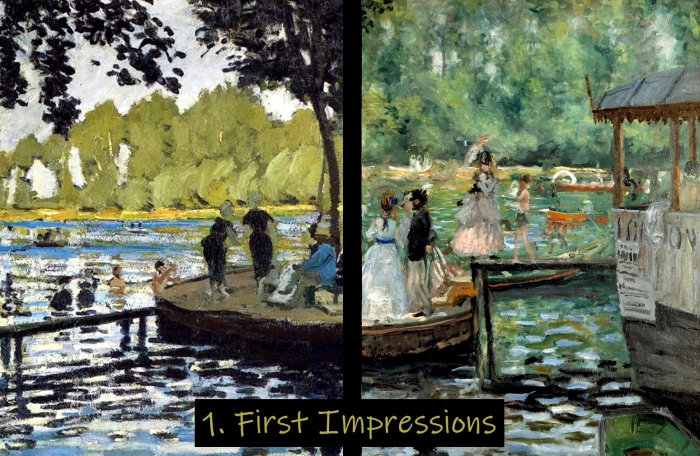
The Scream (1893) by Munch and Self-portrait (1889) by Van Gogh

Van Gogh [clockwise from top left]: Self-portraits, 1888 and 1889;
Portrait of Dr. Gachet, 1890

Munch: The Scream (1983, Oslo NG), a self-portrait from the same year, and Anxiety (1894)
Some questions: Are you influenced by the title/nickname of either picture? Are there differences between the ways Van Gogh paints the face, the clothes, and the background? How would it be if the background were smoother? Can you conceive the Munch without the foreground figure, or the figure without the background? Which painting is the more explicit in its emotion, and what makes it so? Where does each stand in comparison to the normal style of the artist?
Some facts: The smaller pictures show a self-portrait from 1887 and Van Gogh's Portrait of Dr. Gachet from 1890. Can you say that the emotion is the same in all three? Munch originally titled his piece "The Shriek of Nature," and records his experience in landscape terms: "Suddenly the setting sun turned the clouds a blood red. [I sensed an] infinite scream passing through nature." On the other hand, his self-portrait of the same year, and later reworking of the same composition with the title Anxiety suggest that his meaning is indeed a personal one.
COMPARISON 2

Two self-portraits by Lovis Corinth, 1911 and 1914

Corinth: Self-portrait as a Flag-Bearer (Poznan)

Corinth: Self-portrait in Harness (Hamburg)
Some questions: What are the props in each picture? What is the palette (range of colors) in each? Which seems the more staged? Just looking at the faces, do you see any difference in attitude? Which picture is earlier, and why do you think so?
Some facts: Corinth painted a self-portrait every year on his birthday. Some are more or less natural; some, like these, are dressed up. Two outside events come between the upper picture (1911) and the lower one (1914): the personal upheaval of a crippling stroke in 1912, and the historical one of the outbreak of WW1 in 1914.

Corinth: The Blinded Samson (1912) and Cain (1917)
Some questions: If you saw these without titles, could you say what they represented? What is the action of each? Does either contain elements not necessary for the Biblical story? Does either look like a self-portrait? How would you describe the predominant emotion in each? How does this relate to what you know of Corinth's personal history, and the history of Germany?
COMPARISON 3

Kirchner self-portraits with a model

Kirchner: Self-portrait with Model (1910, Hamburg)

Kirchner: Self-portrait as a Soldier (1915, Oberlin College)
Some questions: A dumb question perhaps, but which picture is earlier? What is Kirchner doing in the earlier one that he is not in the later? Which hand did he use in painting the second one? Some of the colors are the same in each picture, others are different; what effect does this have? What can you deduce from the clothing (or lack of it) in each?
Some facts: Ernst Ludwig Kirchner (1880–1938) was the co-founder of the Expressionist group Die Brücke (the bridge) in 1905, and its leading figure. At the outbreak of WW1, he volunteered for service as a driver, but was invalided out due to poor health, both mental and physical. He never saw action, and was never wounded.
COMPARISON 4

Oskar Kokoschka: Bride of the Wind and The Power of Music

Kokoschka: Bride of the Wind, aka. The Tempest (1913–14, Basel)

Kokoschka: The Power of Music (1918, Eindhoven)
Some questions: [I originally showed these without dates or titles.] At first glance, what is the dominant emotion in each? How would you describe the palette of each, the brushwork, the sense of movement? Does each contain a center of stillness? What is the relationship between the male and female characters in each? How old is the figure in the red shirt, and what is he doing? Having now looked more carefully at each picture, has your opinion changed about its emotional content?
Some facts: The figures in the upper picture are Oskar Kokoschka (1886–1980) himself and Alma Mahler (1879–1964), a remarkable woman who was married in turn to the composer Gustav Maher, the architect Walter Gropius, and the writer Franz Werfel. She also had extended affairs with Alexander von Zemlinsky (another composer) and between 1912 and 1914 with Kokoschka. The painter was obsessed with her but did not succeed in getting her to marry him. The left-hand picture is clearly in the midst of their relationship, and the right-hand one is generally thought to look back on it. The earlier picture is now called Bride of the Wind, but Kokoschka originally gave it the title Weakness and Strength.
COMPARISON 5

Two music lessons by Henri Matisse, 1916 and 1917

Matisse: The Piano Lesson (1916, NY MOMA)

Matisse: La famille, aka. The Music Lesson (1917, Barnes Foundation)
Some questions: The two paintings clearly represent the same subject and the same setting, identified as the living-room of Matisse's home near Paris. What are the differences in their color, paint handling, and overall style? Which picture has the greater depth? Is either of them realistic? What kind of lines do you find in each? What about the objects on each piano; are they significant? Which picture is the earlier?
Some facts: Both pictures were painted during WW1; the one on the left in 1916 and the other in 1917. Henri Matisse (1869–1954) volunteered, but was too old; he records feeling ashamed of his uselessness. The right-hand picture was originally called The Family; its present title The Music Lesson was given it by its purchaser Albert C. Barnes. The figures represented are the artist's younger son at the piano, his daughter behind him, his elder son in the foreground, his wife out in the garden, and the painter himself represented by his violin on the piano. The elder son, Jean, has just been called up to report for duty the next day.
See here for an
excellent and timely essay on these two paintings that combines academic rigor with interesting reflections on the lockdowns involved in being an ordinary citzen in the First World War, and under quarantine for COVID a century later.

Matisse: Le bonheur de vivre (1906, Barnes Foundation). CLICK FOR MORE.

Matisse: Le bonheur de vivre with engraving by Agostino Carracci

Matisse: La danse (1909, NY MOMA) and Still Life with La Danse (1909, St. Petersburg)
Some questions: Describe the combination of colors in the painting, the rhythm of its shapes, its general mood? Are there any straight lines, and what do these do? Are all the figures painted in the same relative scale? What are they doing? How many references are there to music? Are there any elements you might call pastoral?
Some facts: It is thought that Matisse was influenced by an engraving by Agostino Carracci from just before 1600, called Love in the Golden Age. It is a pastoral with similar action, similar nude figures, and a very similar ring of dancers in the background. Matisse would focus on the dance motif in at least two other pictures, one of which features in the background of his sunny Still Life of 1909.
MUSIC: Check the links below to hear or see the various music selections played in the second hour. The last link is to a Young People's Concert with Leonard Bernstein and the NY Philharmonic, in which the orchestra improvises a possible final planet, Pluto, the Unpredicatable.
Villa-Lobos: Symphony 3 (War), last movement
Villa-Lobos: Symphony 4 (Victory), last movement
Holst: The Planets, Mars
Holst: The Planets, Jupiter
Holst: The Planets, Neptune
Holst: The Planets, complete, with two-piano score
Bernstein: The Planets, Pluto (orchestral improvisation!)
The script for this part of the class can be found here. The poem "I vow to thee, my country," as set by Holst, is here.
ARTICLES: I do not have books to suggest for this class, but would direct you to the following online articles dealing with specific aspects. The Elderfield article on Matisse is the most scholarly, but also the most topical and interesting. All the others are brief, and geared to the general reader. [• the green dots are links]
CORINTH. Survey of his later career. (EclecticLightCo, 2017)
— three excellently illustrated articles on his self-portraits and stroke.
•
•
•
KIRCHNER. Self-portrait as Soldier (Khan Academy)
— undergraduate-level article, part of a generally fine series.
•
KOKOSCHKA. The Power of Music (Van Abbe Museum)
— an especially informative catalogue entry.
•
MATISSE. Le bonheur de vivre (Khan Academy)
— undergraduate-level article, part of a generally fine series.
•
MATISSE. Lockdown: Matisse's Domestic Interiors (Gagosian, 2020)
— excellent article by John Elderfield on the Music Lessons.
•
PEOPLE: Here are brief bios of the artists considered in the class, in order of birth.
You can access all biographies via the BIOS link on the syllabus page.
 |
Vincent van Gogh, 1853–90. Dutch Post-Impressionist painter. Beginning in his native Holland with dark paintings of peasant life, his style was transformed when he went to Paris in 1886, and thence to Arles, where he lived with Paul Gauguin. Although prolific in his output, he suffered from severe depression and eventually shot himself, while living close to his doctor in the north of France. |
 |
Edvard Munch, 1863–1944. Norwegian painter and printmaker. Tormented by the legacy of childhood trauma (he wrote "illness, madness, and death were the black angels that kept watch over my cradle"), Munch nevertheless managed to turn his neuroses into art that can stand with the most advanced painting in the rest of Europe and makes him a prime exponent of Expressionism. |
 |
Lovis Corinth, 1858–1925. German painter. After training in Paris, he was hailed as a proponent of "German Impressionism," although his affinities were more with Rembrandt and Manet. Two things affected the Expressionist freedom of his later style: marriage to one of his young students, and his recovery from a crippling stroke in 1911. |
 |
Henri Matisse, 1869–1954. French painter and sculptor. Matisse and Picasso stand as the giant pillars of French art in the first half of the 20th century. Matisse was the slower starter and the less versatile, but he stands alone for the richness of his color and the sensuality of his forms, whether in painting or in sculpture. Suffering from crippling arthritis at the end of his life, he produced a completely new oeuvre in colored-paper collage. |
 |
Gustav Holst, 1874–1934. English composer. The son of a church organist of Swedish descent, Holst studied first the piano and then the trombone. With Ralph Vaughan Williams, he was largely responsible for the revival of interest in English folk music at the turn of the century. He worked most of his life as a church musician and in education, but wrote numerous works, of which The Planets (1918) is the largest and most famous. |
 |
Ernst Ludwig Kirchner, 1880–1938. German painter. Kirchner was the co-founder of the Expressionist group Die Brücke (the bridge) in 1905, and its leading figure, painting incisive angular figures in strong colors. At the outbreak of WW1, he volunteered for service as a driver, but was invalided out due to poor health, both mental and physical. He never fully recovered, and spent the last part of his life in seclusion in Switzerland. |
 |
Oskar Kokoschka, 1886–1980. Austrian painter and playwright. One of the leading Expressionist painters in Vienna, Kokoschka was also a poet and playwright. Starting mainly as a portraitist with a distinctive style of very free brushwork, he widened his interests to include landscapes, cityscapes, and other subjects when he began to travel in the later 1920s. Denounced as degenerate by the Nazis, he became first a Czech and later a British citizen. |
 |
Heitor Villa-Lobos, 1887–1959. Brazilian composer. Villa-Lobos studied the cello with his father and made an early living playing in orchestras, but as a composer he was largely self-taught. Visiting Paris in 1927–30, he picked up the prevailing neo-classicism, and returned to Brasil to write a series of pieces called Bachianas Brasilieras infusing baroque forms with Brazilian folk styles. |
